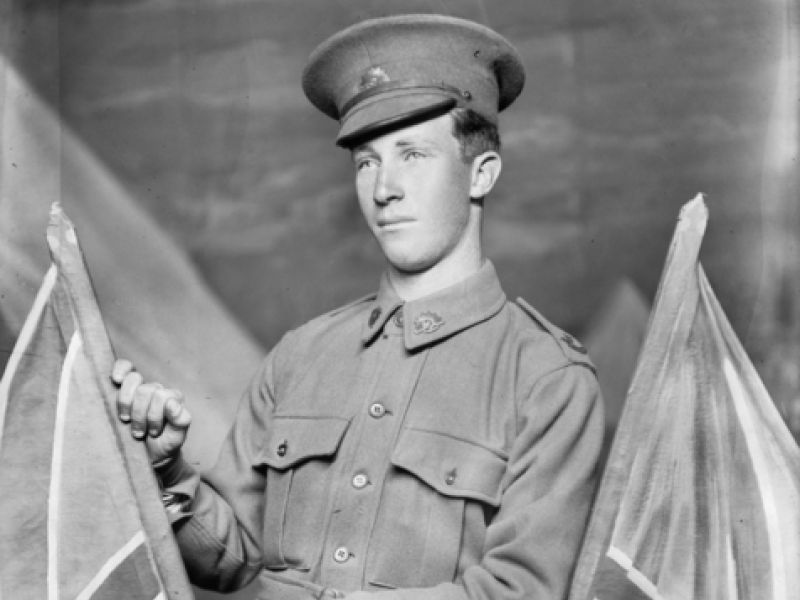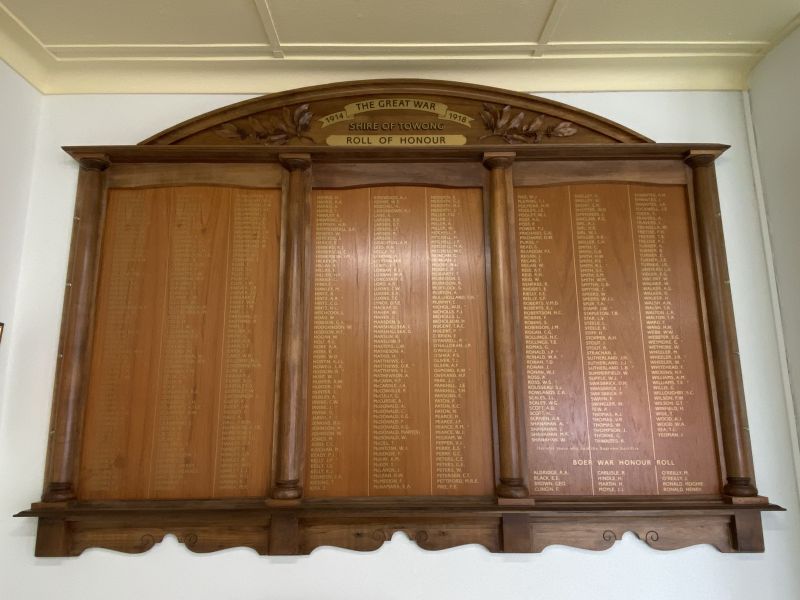Gilbert Harold Hindle
Gilbert was born in September of 1896 at Tallangatta, Victoria. He was one of five children of Joseph Illingworth and Elizabeth Ann (née Gilbert) Hindle. Gilbert’s parents had emigrated from New Zealand prior to their first child, Dulcie, being born in Tallangatta in 1894. The Australian Electoral Rolls show that while the family lived in Tallangatta, Joseph’s occupation was a rate collector. The family moved to Caulfield, near Melbourne around 1911 and Joseph continued to collect rates.
Gilbert attended three different schools; Tallangatta State School, Caulfield State School and Swinburne Technical School. As he listed “carpenter” as his occupation on his enlistment papers we can assume that this was his area of study while he attended Swinburne. Gilbert also completed his cadet training and served for one year in the 29th Light Horse, where he qualified for the rank of corporal.
On the July the 20th, 1915, Joseph Hindle sat down at his kitchen table and write a letter that he would no doubt come to regret in the years to come. Gilbert was desparete to enlist but being only 18 years of age, he needed his parents permissions. It was only three months since Australian troops had stormed the dry, scrubby hills of Gallipoli. The long casualty lists of the August offensives at Lone Pine, the Nek and Baby 700 were only a few weeks away. By then, Gilbert was Private Gilbert Hindle, Regimental Number 3134 of the 7th Reinforcements for the 21st Infantry Battalion, Australian Imperial Forces.
The 7th Reinforcements embarked from Melbourne, Victoria, on board HMAT A18 Wiltshire on the 18th of November 1915. By the time they disembarked in Egypt, Allied forces had withdrawn fro the Dandenelles. Gilbert contracted influenza in mid February of 1916 and was admitted to the 1st Australian General Hospital at Heliopolis. Two weeks later he was taken on strength with the 60th Battalion. On the 18th of March he was transferred to the 15th Australian Machine Gun Company of the 5th Australian Division. After three months of training, the company embarked at Alexandria to join the British Expeditionary Forces on the Western Front. Gilbert spent two weeks in an isolation ward of the 15th Field Ambulance in France. Although the reason is not given, various infectious diseases such as measles and mumps were rampant in the close living conditions in the field. After another period spent in hospital in September, Gilbert was sent to England for further training at the Machine Gun Training Depot in Tidworth, Wiltshire.
In early February of 1917, Gilbert attended a Machine Gun School at Camiers in the north of France. The company was to take a part in the Second Battle of Bullecourt, a renewed attempt to seize an advance German stronghold on the Hindenburg Line. The company war diarist wrote on the 10th of May;
“During the morning there was intense artillery activity on both sides. Two of our guns were put out of action by shell fire. The afternoon was comparatively quiet.
Casualties 2 O/R (other ranks).”
Gilbert was one of the OR’s wounded. He was hit by shrapnel in the right shoulder and sent back to the 5th Division Rest Station. He rejoined his unit four days later. On the 1st of June he was promoted to temporary Corporal. On the 6th he was detached to the anti-aircraft guard at Méaulte near Albert. Three weeks later he was transferred to the anti-aircraft guard at the village of Acheux, ten kilometeres north-west of Albert.
When not in the front line, troops would occupy the various villages behind the line. Men were also granted a 10-day leave pass that they could use to go to Paris or England. Most Australians, with their English backgrounds, chose to go to the England. Gilbert had his leave between the 23rd of July and 4th of August, 1917. Arriving back from leave he was promoted to full Corporal. In early Septmeber he was detached for duty to the Machine Gun Depot at Grantham, so back he went to England.
On the 21st of January, 1918, Gilbert decided to have some unofficial leave. Unfortunately he was apprehended on his way back into camp and was charged with having been absent without leave from “5 pm 21-1-18 to 10 pm 22-1-18”. He was reprimanded by Major E Sexton and forfeited two days pay.
It was a fine and clear day when, on the 12th of March 1918, Gilbert returned to his unit. The 15th Machine Gun Company was billeted near Messines in Belgium. A little over two weeks later the company would be involved in the First Battle of Viller-Bretonneux.
Gilbert’s Red Cross File explains what happened to him.
“Died of Wounds
I was with Hindle and two others in billets at Corbie on 4th April. In afternoon 2 p.m. shell fell right into building. Hindle was hit badly about the head and shoulder. - conscious. and complaining about his wounds - taken by Ambulance to C.C.S. along with myself. He died two days after at Amiens C.C.S. I was in C.C.S. when he died - know nothing of burial. Knew him as Gil. The two other men were taken away before us on stretchers. Pte. H. Gyer 1797 15th M.G.C. died of wounds next day and was buried in cemetery near Amiens. Pte. T. Hennis. No — 15th M.G.C. was killed outright. Don’t know where buried.
Informant:- Pte. R.P. Henry. 3545
15th M.G.C.
HAREFIELD”
Gilbert was buried in the Vignacourt British Cemetery, France. He is also remembered at the Australian War Memorial Roll of Honour, and the Boer War and WW1 Roll of Honour at Tallangatta, Victoria. For his service he was awarded the 1914- 15 Star, the British War medal and the Victory Medal.

 Stephen Learmonth
Stephen Learmonth